Understanding Diamond Cuts: Impact on Brilliance and Value
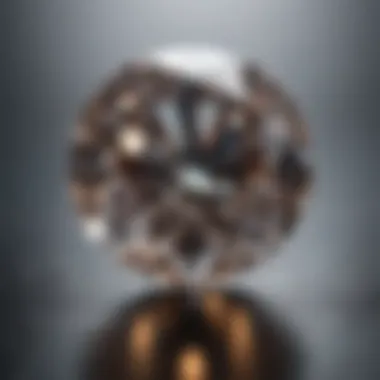
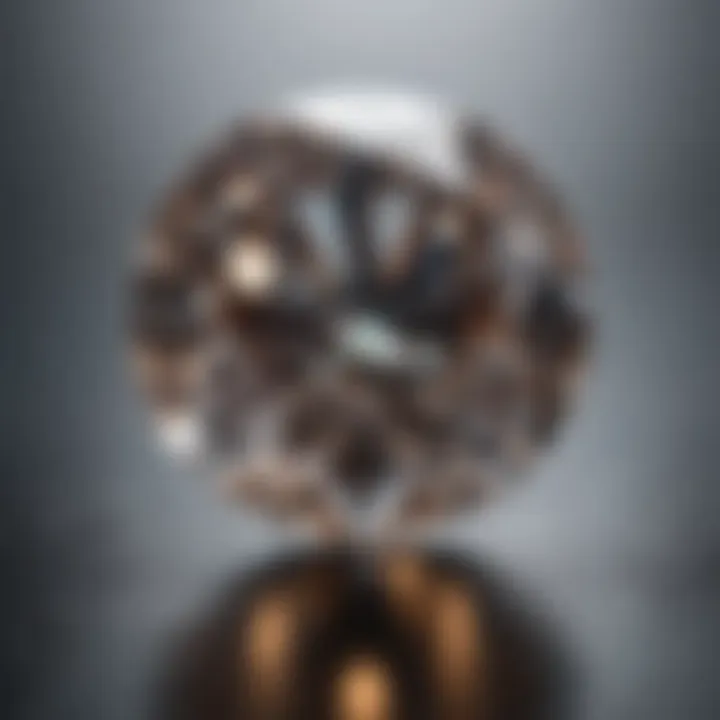
Intro
Diamonds, the unyielding gems that have captured hearts for centuries, hold a myriad of secrets within their sparkling facets. At first glance, they may appear to be simply beautiful stones, but their brilliance is intricately tied to how they are cut. Understanding the nuances of diamond cuts is central to grasping their impact on both aesthetics and value. The art of diamond cutting can be an elaborate dance between mathematical precision and artistic expression, determining how light interacts with the stone.
As we dive deeper into the world of diamond cuts, we will explore the standard classifications, quality indicators, and historical context that have shaped our perception of these glittering symbols of love. This is an exciting journey for gemstone enthusiasts, collectors, and jewelry designers alike. Not only does it unlock the path to selecting the right gem, but it also enriches our appreciation of this extraordinary material.
Gemstone Overview
Diamonds belong to a fascinating category of gemstones that has not just evoked desire but also commanded significant value across centuries. They are often deemed the "king" of gemstones, standing out due to their unique properties and enchanting allure.
Definition and characteristics
A diamond, defined by its structure of carbon atoms arranged in a crystal lattice, exhibits unmatched hardness as well as a remarkable ability to refract light. Their transparency and clarity are unmatched, making them a favored choice for various ornamental and practical uses. These stones come in a variety of colors, including the classic colorless as well as pink, blue, and even rare shades such as green or red. Each type, with its own unique attributes, contributes to the overall allure of diamonds.
Classification of gemstones
Gemstones can be classified broadly into two categories: precious and semi-precious. Diamonds fall under the category of precious gemstones, laced with cultural significance and luxurious appeal. While shape, color, and clarity define their physical identity, the cuts make them truly distinctive. Some of the well-known diamond cuts include:
- Round Brilliant
- Princess Cut
- Emerald Cut
- Asscher Cut
- Marquise Cut
Each cut not only influences the diamond's appearance but also its ability to reflect light—an essential factor in its overall brilliance.
Properties of Gemstones
Understanding diamond cuts necessitates an appreciation of the physical and chemical properties of these gems.
Physical properties
Diamonds possess extraordinary physical attributes. Their hardness makes them nearly impossible to scratch, thus preserving their clarity over time. The ability to conduct heat is another significant physical characteristic, setting diamonds apart from other gemstones. Their brilliance, the measure of how well they reflect light, is heavily influenced by the cut and symmetry of the stone.
Chemical properties
At its core, a diamond is composed entirely of carbon. This simple element undergoes intense pressure over years to form the striking gemstones we see today. The incorporation of trace elements during formation can lead to variations in color and clarity, giving rise to the breathtaking palette of diamonds.
"The beauty of a diamond is not just skin deep; it runs through its very structure, shaped by nature and human hands alike."
In the subsequent sections, we will unpack the intricate tapestry of diamond cuts and how each aspect cultivates the radiance these gems are famed for. Everything from the symmetry and proportion to historical perspectives will be explored, providing a detailed lens through which to understand and appreciate these magnificent stones.
Preamble to Diamond Cuts
The world of diamonds is not merely defined by their rarity or color; rather, it is the cut that truly unleashes their intrinsic beauty. When discussing diamond cuts, it's crucial to recognize their pivotal role in determining how light interacts with the stone. A well-executed cut can amplify a diamond's brilliance, while a poorly executed one may leave it looking dull and lifeless.
The cut of a diamond influences its overall aesthetic appeal, greatly affecting how it sparkles and reflects light. This isn't just an abstract concept—it's a fundamental aspect that jewelers and enthusiasts alike must understand. Not only does the cut dictate visual performance, but it also plays a significant role in the diamond's valuation.
Key elements to consider about diamond cuts include:
- Brilliance and Sparkle: The quality of the cut directly impacts how well a diamond reflects light.
- Shape and Style: Different cuts result in different shapes, each appealing to various tastes and preferences.
- Value: Cut impacts a diamond's price; better cuts often command premium prices in the market.
Being familiar with cuts is crucial for anyone venturing into the diamond market—whether you’re a novice looking for an engagement ring or a seasoned collector aiming to invest. Understanding how the cut contributes not just to beauty, but also to value, is essential in making informed decisions.
The Importance of Cut
The importance of cut in the diamond world cannot be overstated. It is essentially the diamond's "face"—what you see first and foremost. A superbly cut diamond sparkles, throwing flashes of light in all directions, captivating the eye. This brilliance is characterized by how well the diamond returns light to the observer.
When a diamond is cut too shallow or too deep, it disrupts the light's path. Instead of a vibrant sparkle, you might see a dull appearance.
- Cut Quality Factors: Factors such as symmetry, proportion, and polish are evaluated to determine cut quality.
- Grading Scales: Institutions like the Gemological Institute of America (GIA) provide grading services to help buyers understand a diamond's cut quality.
Choosing a high-quality cut can enhance the diamond's beauty, ultimately impacting its desirability and price.
A Brief Historical Perspective
The journey of diamond cutting has been long and intricate, evolving alongside human civilization. In ancient times, diamonds were prized for their hardness and unique properties. However, the true artistry of diamond cutting didn’t emerge until the late Middle Ages.
Initially, diamonds were simply polished rather than cut into specific shapes.
- Early Techniques: The first cuts were basic and didn’t take light reflection into consideration.
- Renaissance Influence: It wasn't until the Renaissance that innovation in cutting techniques began to flourish, spurring the development of brilliant and fancy shapes.
As we moved into the 20th century, technological advancements and the rise of consumerism led to the popularity of structured cuts. Jewelers and gemologists sought to maximize the diamond's aesthetic appeal, giving birth to modern cutting styles such as the round brilliant cut, which remains the most popular true classic today.
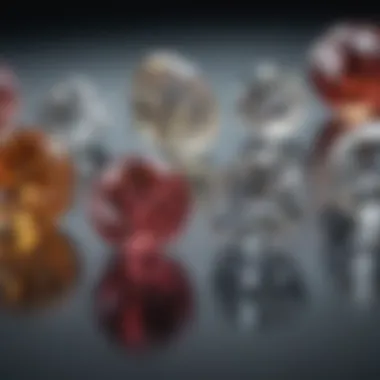
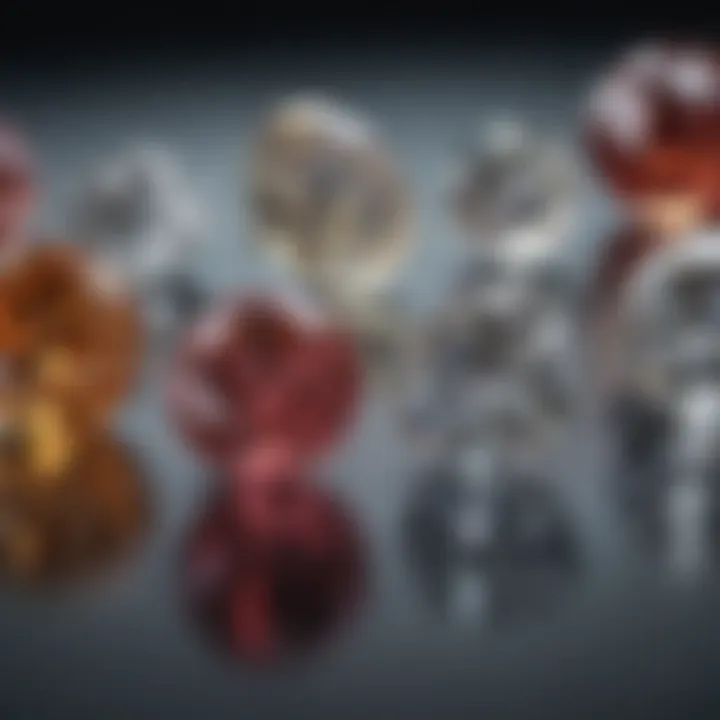
Understanding this historical context enriches our appreciation of diamond cuts and highlights how skillful craftsmanship turns a raw piece of stone into an object of timeless beauty.
Cut Types Explained
When it comes to diamonds, the cut is more than just a physical attribute; it’s a shining beacon of brilliance and a crucial factor behind a diamond's allure. Understanding the different types of cuts is essential for anyone who seeks to appreciate a diamond's full beauty and gather insight into its pricing. Each cut type carries with it a unique identity, advantages, and often a deeply rooted history.
Round Brilliant Cut
Characteristics
The round brilliant cut is perhaps the most well-known and sought-after diamond cut. It typically features 58 facets, designed in a way that maximizes the light interaction and brilliance. One of the most defining characteristics is its ability to reflect light from multiple angles. The strong symmetry and proportional dimensions contribute significantly to how light moves through this diamond, creating a stunning visual effect. The brilliance of a round cut isn’t simply a matter of looks; it plays a pivotal role in its popularity. If one is hunting for a diamond that showcases sparkle, a round brilliant cut could be the home run.
Popularity and Trends
This cut's current standing in the market remains unmatched, consistently leading in sales year after year. The round brilliant cut is not just about tradition; it’s influenced by consumer preferences and the desire for classic beauty. As trends shift, one might notice vintage or fancy cuts gaining a spot in the limelight, but nothing quite beats the enduring appeal of the round shape. It’s like a classic record that refuses to go out of style. The only downside might be the price, which tends to be higher due to demand and popularity.
Princess Cut
Features and Benefits
The princess cut has made a name for itself as the modern counterpart to the round brilliant cut. With sharp lines and a square or rectangular shape, it emphasizes the diamond's natural brilliance while offering a different aesthetic. Among its key features is the capability to showcase the stone’s carat weight effectively, often giving the illusion of a larger diamond. Its unique choice of facets can also yield impressive fire and scintillation, making it a strong contender in the realm of diamond choices, especially for those inclined towards contemporary styles.
Market Presence
In recent years, the princess cut has seen a significant uptick in popularity. This trend mirrors the tastes of younger generations seeking unique and modern diamond styles. However, it still trails behind the classic round brilliant cut in terms of market share. Many consumers appreciate the versatility it offers, lending itself well to various settings, from engagement rings to earrings. Furthermore, its affordability compared to round cuts plays into its favor, creating a compelling choice for budget-conscious buyers who desire elegance without breaking the bank.
Emerald Cut
Design and Appeal
Emerald cuts, with their long lines and step facets, stand out for their elegance and sophistication. The design allows for a unique showcase of the diamond’s clarity, making it an exquisite choice for buyers who appreciate a clean, refined look. More than anything, emerald cuts radiate a vintage charm, often favored by those seeking timeless designs in their jewelry. The unique feature here is the "hall of mirrors" effect, where the cut creates a captivating interplay of light and dark, offering a different type of drama.
Uses in Jewelry
Emerald cuts have been a prominent choice in high-end jewelry pieces, often seen in celebrity engagement rings or statement necklaces. Its elongated shape is particularly appealing when crafted into elongated rings or cuffs, showcasing the stone in a way that takes full advantage of the available surface area. However, the stone’s clarity takes precedence, and imperfections can become quite noticeable, which adds a layer of consideration when selecting this cut compared to others.
Asscher Cut
Unique Attributes
The Asscher cut is often likened to the emerald cut but features a square shape and a higher crown. One of its key characteristics is the deep pavilion, which enhances the diamond's depth and gives it a dramatic presence. The cut’s unique and geometric lines create a spectacular light reflection, leading to captivating sparkle. This cut carries an aura of vintage elegance, remniscent of the early 20th century, thus appealing to those who cherish nostalgia in their jewelry pieces.
Comparison to Other Cuts
When compared to its rival cuts, the Asscher cut shines in its ability to balance style and substance. While it may not reach the popularity of the round brilliant cut, its unique aesthetics make it a distinctive option. Its complex facets demand higher precision and skill during the cutting process, which means that good quality Asscher cuts may come with a higher price tag due to the craftsmanship required. Moreover, the Asscher cut is often viewed favorably by collectors and connoisseurs who appreciate the historical value behind it.
Other Cuts
Marquise, Oval, and Pear Cuts
Each of these cuts carries its own charm and distinctiveness. Marquise cuts present a football-like shape, designed to appear larger than their weight due to their elongated silhouette. Oval cuts blend the brilliance of the round cut but allow for more creative settings. Meanwhile, pear cuts, with their teardrop look, offer a unique flair that can be both whimsical and sophisticated. Their distinct characteristics make them intriguing, although market presence fluctuates with trends.
Less Common Options
Beyond these popular cuts, there exists a world of less common options. Cuts like the cushion cut, radiant cut, and even the heart shape cater to niche preferences. While they may not dominate the market, they attract those looking for individuality in their gemstones. Each of these cuts serves to remind us that the world of diamonds is indeed vast and rich with choices, resonating with a different audience often seeking something beyond the ordinary.
Quality of Cut and its Significance
When it comes to diamonds, the quality of cut plays an instrumental role in determining not just the diamond's appearance, but also its market value. The cut decides how well light refracts through the gemstone, significantly influencing its sparkles and brilliance. For enthusiasts and jewelers alike, understanding the nuances of cut quality is essential. It connects both the artistic craftsmanship and the geometric precision required to create a truly stunning diamond.
The cut of a diamond dictates the stone's overall character. It’s the reason a diamond can shine like the morning sun or appear dull and lifeless. The intricacies of the cut can accentuate the diamond's clarity and color or, conversely, amplify its flaws. Knowing the quality of cut can transform an average diamond into a brilliant one, making this topic worth a deep dive.
Understanding Cut Quality
Factors Influencing Quality
The quality of a diamond's cut is influenced by several factors. The angles and proportions of the diamond play a significant role here. A well-crafted diamond will have precise angles and proportions that allow light to enter and exit in a way that maximizes brilliance. The depth and table percentages also contribute to this.
Understanding these factors helps both buyers and sellers evaluate worth. For instance, if a diamond has too shallow a cut, light escapes instead of reflecting, leading to poor performance. Therefore, an effective cut not only enhances beauty but also sustains value over time. In this context, the emphasis on craftsmanship becomes clear; it’s not just about making things look pretty.
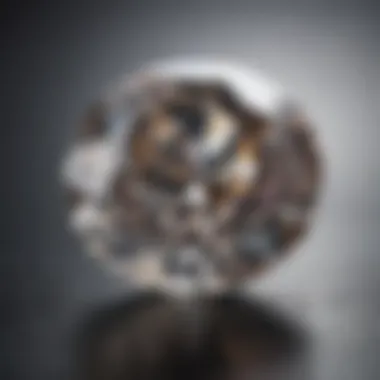
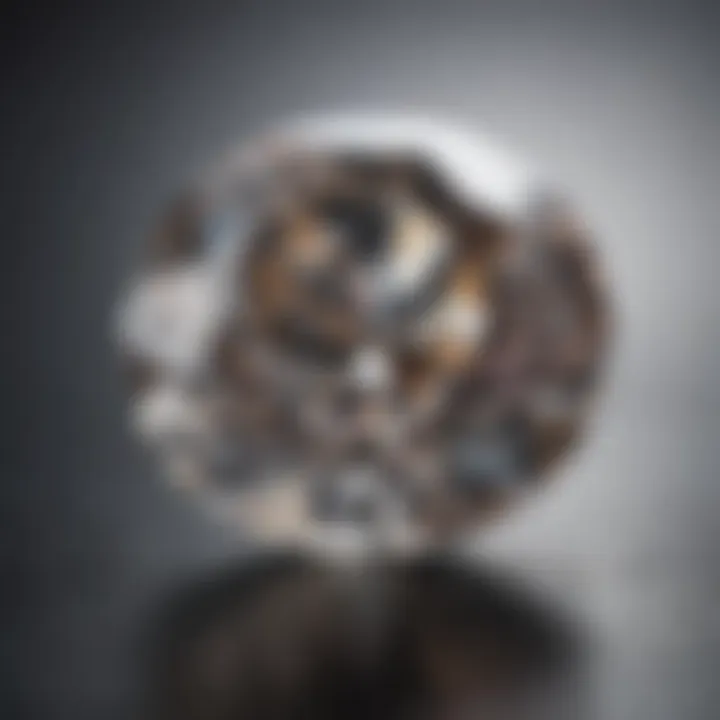
Grading Systems
Grading systems have been developed to evaluate cut quality, with the most recognized being the GIA (Gemological Institute of America) system. This grading helps assess a diamond's cut using standards that evaluate proportions, symmetry, and polish. The clarity in grading also allows consumers to make informed decisions based on personal preference and budget.
Each grade carries specific characteristics, making it easier for diamond buyers to understand what they are purchasing. For example, a “Excellent” cut will have superior angles, leading to remarkable light performance, while a “Fair” cut might lack brilliance and depth. The grading system thus acts as a roadmap for both novice and seasoned buyers in navigating their options.
Impact on Performance
Brilliance and Sparkle
Brilliance describes how much white light is reflected back to the observer, while sparkle addresses how the light is scattered. These elements hinge on the diamond's cut quality. A diamond with an excellent cut will exhibit vibrant brilliance and captivating sparkle, often capturing the attention of those nearby. The playfulness of light reflects the diamond’s quality and can elevate its perceived value instantly.
Ideally, for someone investing or gifting a piece, understanding brilliance and how it correlates to quality can help in making a conscientious choice. The twinkle in a well-cut diamond can signify craftsmanship and attract admirers alike. However, a poorly cut diamond may not radiate the same charm, often leaving one feeling disappointed.
Light Interaction
Light interaction is the heart of what makes diamonds mesmerising. Different cuts interact with lightwaves in varying ways, affecting the way colors are absorbed and reflected. Properly cut diamonds capture more light through their facets, resulting in a play of colors that few gems can rival.
One aspect worth mentioning is the unique feature of ideal cuts, which can maximize light performance due to their proportions. However, not every diamond needs to follow this template; some alternative cuts can produce stunning visual effects. Understanding this interaction offers a more nuanced perspective on diamond quality and opens options for more unique gemstone selections.
The Science Behind Diamond Cutting
Understanding the science behind diamond cutting is crucial for anyone keen on grasping the intricate details that influence a diamond's brilliance and overall value. The cutting process plays a pivotal role in not only aesthetic appeal but also in reflecting light in ways that enhance a diamond's qualities. Powerful tools and advanced techniques are employed to shape diamonds, reflecting both artistry and technological ingenuity. The following sections will highlight some of these transformative advancements in diamond cutting, breaking down the contribution of both manual craftsmanship and modern machinery.
Technological Advancements
Laser Cutting Techniques
Laser cutting techniques have revolutionized the diamond industry. This method employs high-powered lasers that offer precision beyond traditional cutting methods. The ability to make intricate cuts with extreme accuracy is a key characteristic of this approach. The speed and efficiency of laser cutting make it a popular choice in contemporary diamond processing.
A unique feature of laser cutting is its capability to execute complex designs that were once thought to be impossible. For instance, the precision of lasers allows cutters to create intricate patterns that maximize light performance, enhancing the stone’s sparkle and overall appearance. However, some purists argue that this method may lack the soul and personal touch that comes with traditional cutting, leaving a mere technical imprint on a stone that could otherwise have an emotional narrative.
Precision and Accuracy
Precision and accuracy are hallmarks of modern diamond cutting techniques. These elements ensure that every facet of the diamond is expertly crafted, allowing for optimal light reflection and refraction, which are crucial for achieving brilliance. Accurate cuts lead to better symmetry, which in turn affects both the aesthetic appeal and the market value of the diamond.
One unique aspect of precision in diamond cutting involves the use of computer-aided design (CAD). This technology gives cutters the ability to model the desired stone digitally before making any physical cuts. Although CAD provides near-perfect outcomes, it can sometimes distance artisans from the hands-on approach that has characterized diamond cutting for centuries. This ongoing debate brings to light the balance between modern efficiency and artisanal skill.
Manual vs. Machine Cuts
Traditional Craftsmanship
Traditional craftsmanship in diamond cutting is an art form that has been refined over centuries. This labor-intensive method is characterized by the skilled hands of experienced artisans who cut and shape diamonds using simple tools. The beauty of this approach lies in its personal touch and unique imperfections that can give each stone its character.
The process often involves a deep understanding of the diamond's natural properties, allowing the cutter to work with its strengths rather than against them. This intrinsic knowledge results in a stone that not only shines but tells a story. However, the downside is that this method is typically more time-consuming and can be less consistent compared to machine cuts, leading to potential variations in quality.
Modern Innovations
Modern innovations in diamond cutting have introduced a range of methods that greatly enhance efficiency and precision. Techniques such as robotic cutting and advanced machinery allow for replicability and uniformity, qualities highly valued in today’s market. These machines can work tirelessly, often producing multiple stones simultaneously with minimal error.
The uniqueness of modern cutting lies in its ability to blend rapid production with sophisticated designs. While this attracts businesses aiming for mass production, some critics voice concerns about the loss of human artistry. The juxtaposition of speed versus craft evokes a broader discussion about the future of diamond cutting in an increasingly automated world.
In summary, the science behind diamond cutting encompasses a blend of age-old traditional methods and innovative techniques. Both play essential roles in shaping the diamond's journey from uncut stone to glittering jewel, each with its own set of advantages and disadvantages. Ultimately, the choice between these methods may reflect personal values about craftsmanship, technology, and the artistry of this remarkable field.
"Understanding the intricacies of diamond cutting not only reveals a deeper appreciation for the gems themselves but also underscores the blend of art and science in their creation."
This section serves to illuminate the advancements that have shaped the diamond industry and the ongoing balance between tradition and modernity, appealing to gemstone enthusiasts and industry professionals alike.
Economic Aspects of Diamond Cuts
Understanding the economic facets of diamond cuts is vital for anyone looking to appreciate these gemstones fully. The cut of a diamond significantly influences its value and desirability in the market. Factors such as how a diamond cut enhances its brilliance, the consumers' preferences regarding styles, and the relationship between cut quality and pricing all intertwine with the broader economic landscape of the diamond industry.
Valuation and Market Trends
How Cuts Affect Price
When discussing how cuts affect price, one must realize this relationship is very nuanced. The cut is responsible not only for how a diamond looks but also its overall worth. A well-executed cut can amplify a diamond's brilliance, enabling it to reflect light in mesmerizing ways. For instance, a Round Brilliant Cut is often at the top of the price ladder due to its ability to dazzle.
On the flip side, it's essential to consider how different cuts depreciate depending on market trends. Some designs, like the Asscher or Marquise cuts, may lose favor over time, affecting their market value. This shows that consumer taste can be a double-edged sword; while a hot trend can skyrocket prices, a shift can lead to plunging values. Ultimately, the distinct characteristic of the cut in determining price makes it a crucial consideration for sellers and buyers alike.
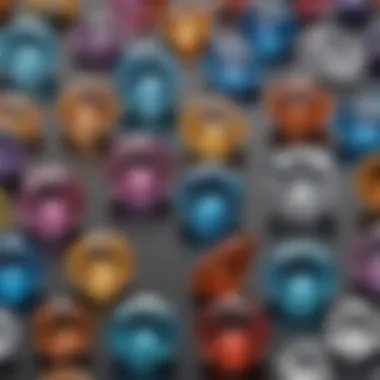

- Benefits: Understanding cut pricing helps potential buyers make informed decisions.
- Disadvantage: Market trends can be volatile, complicating future resale prospects.
Consumer Preferences
The consumer preferences around diamond cuts demonstrate how subjective beauty can be. People have emotional attachments to different cuts, often influenced by cultural backgrounds or personal experiences. For instance, many customers gravitate toward the classic Round Brilliant Cut for engagement rings, while others may look for something unique like a Pear Cut to stand out.
This ties into current market trends, as specific cuts can gain and lose popularity in waves, affecting their availability and pricing. The key is adaptability; jewelers who can predict or respond to changing tastes are more likely to thrive.
- Benefits: Vendors who stay ahead of consumer trends can optimize pricing strategies.
- Disadvantages: Failing to adapt may lead to excess inventory of less popular cuts.
Investment Considerations
Buying Guide for Investors
For someone considering investing in diamonds, having a buying guide for investors is essential. Not every diamond is a good investment; understanding the cut can help differentiate between what may hold value over time and what might depreciate. Accessories or engagement rings featuring popular cuts, like the Round Brilliant and Princess Cut, tend to maintain their value quite well, making them safer choices for investors.
The key characteristic of this guide is focusing on long-term trends rather than immediate gains. A well-placed investment in the right cut can offer rewards years down the line. The unique feature here lies in understanding that an individual’s personal taste in diamonds shouldn’t overshadow solid investment principles.
- Advantages: Knowledgeable investors are less likely to make impulsive purchases based on fleeting trends.
- Disadvantages: Over-analysis might lead to missed opportunities in fast-moving markets.
Future Market Projections
Looking ahead, the future market projections regarding diamond cuts suggest an evolving landscape where trends are increasingly influenced by both technology and shifts in consumer attitudes. As Younger generations come of age, preferences may lean toward ethically sourced and lab-grown diamonds, affecting how traditional cuts are perceived and valued.
The crux of future expectations lies in adaptability to market changes. Emerging technologies in cutting processes could revolutionize how diamonds are shaped and sold, introducing new styles that could captivate the upcoming consumer base. With that, early adopters of these new aesthetics may wind up reaping substantial rewards.
- Advantages: Early investment in trending cuts can lead to considerable profit.
- Disadvantages: Rapidly shifting markets can create uncertainty for investors.
Cultural and Symbolic Significance
In the conversation about diamonds, it's impossible to sidestep their cultural and symbolic significance. Diamonds have transcended mere adornment, becoming powerful symbols woven into the fabric of society. Their allure is tied not just to their physical beauty and brilliance, but also to the stories and meanings that cultures assign to them.
Symbolism of Diamond Cuts
Representation in Society
The representation of diamond cuts in society is multifaceted and deeply rooted in various cultural narratives. Diamonds often signify love, commitment, and even status, with certain cuts becoming associated with specific meanings. For instance, a Round Brilliant Cut, renowned for its ability to reflect light, is frequently linked to romantic gestures such as engagements. This connection between cut and occasion underscores the importance of diamond cuts in shaping societal norms and expectations around relationships.
One of the key characteristics of the representation within society is how different cuts hold varying connotations. The Princess Cut, known for its contemporary edge, reflects modern love stories—often seen as a choice for those who value uniqueness over tradition. The unique feature of this representation lies in its ability to vary across demographics, showcasing personal narratives in a way that's both engaging and relatable. However, this can also lead to limitations, as not every individual identifies with or embraces these societal standards.
Occasions and Usage
When you consider occasions and usage, diamonds cement themselves as central players in major life events. Weddings, anniversaries, and personal milestones often find diamonds at their heart, and the cut can greatly influence the significance of the occasion. For instance, Oval Cuts may symbolize a couple's past and future together, with their elongated shape representing eternity. Their aesthetic appeal and symbolic meanings imbue moments with deeper emotional resonance.
The advantageous aspect of occasions tied to specific cuts is the enhancement of personal and social experiences. They become markers of milestones, celebrating love and commitment in much more than superficial ways. Yet, there's a downside—limiting perceptions that their value lies solely in these monumental moments might overshadow their beauty in everyday life. The emphasis often remains on their use in celebrations, sidelining the joy and expression they provide in more common situations, like gifts or self-purchases.
Regional Preferences
Variations Across Cultures
Diving into variations across cultures reveals that different regions celebrate diamond cuts differently. In some Eastern cultures, for example, diamonds may be less about romance and more about prosperity and status, leading to a greater preference for larger stones rather than specific cuts. In contrast, Western societies lean heavily towards cuts that signify personal connections, favoring those that can be infused with emotion, such as the Heart Cut.
These variations highlight not only individual preferences but also societal values and economic factors that drive choices and styles. This diversity enriches the discourse around diamonds, making it clear that cultural significance often affects the diamond market in numerous ways. However, it can also create misunderstandings among cultures, where a diamond's value perceived in one region may not translate identically in another.
Tradition vs. Modernity
Tradition versus modernity plays a pivotal role in how we perceive and process diamond cuts. Traditional designs like the Round Brilliant Cut often symbolize enduring love and commitment. This classic cut has stood the test of time, providing a sense of continuity in a world that seems to reinvent itself constantly. On the flip side, modern twists, such as the Rose Cut, tend to embrace contemporary aesthetics and preferences, reflecting values like individualism and creativity within relationships.
The beauty of this opposition lies in the dialogue it creates: how do we balance longstanding customs with emerging trends? Some may argue that sticking to tradition offers stability and ties to history, while others might view modernity as an opportunity for self-expression. Each perspective brings its own advantages. Embracing traditional styles can provide a sense of belonging, while modern cuts welcome more diverse influences into personal choice—yet this can also lead to conflicting opinions on what diamonds should represent in today’s world.
In summary, the cultural and symbolic significance of diamond cuts reveals a rich tapestry of meanings and uses that transcend their physical form. The interplay between societal norms, regional preferences, and the ongoing discussion between tradition and modernity shapes how diamonds are not just seen but felt by individuals worldwide. This deeper understanding is fundamental for anyone passionate about gemstones, jewelry, or the stories behind them.
The End
In summation, the exploration of diamond cuts within this article underscores their paramount importance in the gemological arena. Understanding diamond cuts is not merely an aesthetic pursuit; it lays the groundwork for appreciating the intricate balance between a diamond’s brilliance and its overall market value. Ultimately, the cut of a diamond dictates how it interacts with light, influencing the sparkle that captivates observers and collectors alike.
Recapitulating Key Points
Reflecting on the key discussions throughout the article, several pivotal elements emerge:
- Significance of Cut: A diamond's cut is arguably the most critical factor when assessing its beauty and value. Cut quality can either enhance or diminish a diamond's brilliance, irrespective of its size or color.
- Types of Cuts: Various styles, such as the round brilliant, princess, and emerald cuts, each possess unique characteristics that appeal to different tastes and purposes. This diversity caters to a wide consumer base and underlines the importance of personal preferences in jewelry design.
- Quality Evaluation: Understanding the grading systems used to measure a diamond's cut quality equips buyers with knowledge to make informed purchases and investments.
- Cultural Impact: The symbolic meaning attributed to diamond cuts varies across cultures, showcasing their ingrained significance in human society.
Future Directions in Diamond Cutting
Looking ahead, the field of diamond cutting is bound for evolution. Key trends hint at:
- Technological Integration: Advances in cutting technology, such as AI and machine learning, promise enhancements in precision and efficiency during the cutting process. Those developments will likely lead to more consistent quality across different diamond cuts.
- Sustainability Practices: The industry is increasingly aware of its environmental impact. Expect future diamond cutting practices to embrace more sustainable techniques, aligning with the growing consumer demand for ethically sourced stones.
- Customization Trends: As personalized jewelry gains traction, custom diamond cuts catering to individual tastes may emerge. This could foster a deeper connection between the wearer and their piece, accentuating the artistry involved in diamond design.



